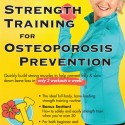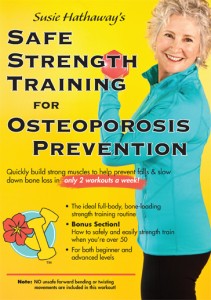

NEW! Free Mini-Workout Log for Your Safe Strength Training for Osteoporosis Prevention DVD!

No time for a full osteoporosis prevention strength training workout? Try this!
New Mini-Workout Exercise Log!
Be sure to sign up for my newsletter to receive the FREE Mini-Workout Log for my Safe Strength Training for Osteoporosis Prevention DVD. You’ll also receive the full-length exercise logs for both DVDs. See the yellow sign-up box in the upper right. —————————————–>
How Effective Are Short Workouts?
Many of you have told me that you’d like to do shorter, more frequent workouts, but are curious if the results will be as good as with longer workouts. Yes, doing short and sweet workouts can be as effective as long workouts! But the catch is that you’ll need to work one particular muscle group in that short time, not your whole body. You’ll also need to put in the equivalent of 2 full strength training workouts a week.
How to Adapt my Safe Strength Training DVD
My Safe Strength Training for Osteoporosis Prevention DVD is designed to work one major muscle group while the others are resting. To do a shorter workout, use the new Mini-Workout Log to keep track of your exercises. Using the forward button on your remote control, you can easily advance through the exercises, picking out all of the arms one day, legs the next, and core (abs and back) on the third day.
Always Do Your Warm-up!
Now, even if you’re short on time, never begin your strength training workout with cold muscles! Always do your warm-up to prevent muscle strain or injury. Believe me, it’s well worth the 5 minutes. I’d rather see you do fewer strength training exercises than skip your warm-up.
 How to Adapt my Resistance Band DVD
How to Adapt my Resistance Band DVD
If you’re using my Resistance Band Training for Osteoporosis Prevention DVD, you know that it’s already divided by major muscle groups. Pick and choose which area to do that day, scheduling the time to always do the 5-minute pre-workout warm-up. You can cool down with the post-workout stretches for the particular muscle group that you’re working that day.
Scientific Information & Practical Tips
For the science behind why to split up your workouts by major muscle group, read my recent blog post, Shorter Workouts for Strong Bones and for practical tips, read Holiday Workouts – 5 Tips to Get It Done!
Mini-Workouts Are Helpful with Chronic Health Issues
Women with health issues such as Chronic Fatigue Syndrome have found these mini-workouts much more doable than one long workout. Sometimes, they’ll need to add rest time between the moves and only do a couple of exercises per workout. As their body adapts and gets stronger, they gradually add more exercises. It’s a good way to ease into strength training if you’re quite out of shape, after an illness, or with chronic health conditions.
Do you have any tips that you find helpful with mini-workouts? Let me know or ask a question below!
Thanks!
–Susie
Susie, you are an angel to share your research and expertise with us to help us keep our bones strong!
Bless you!
Liz
🙂 My pleasure and thanks, Liz!
Hi Susie, I loved your Safe Strength Training DVD and would like to know if you will have another DVD like it coming out? I am not a fan of resistance bands though so I was hoping you had another with hand weights planned. Also, I would like to say thank you for putting these DVDs out and giving me hope that I am doing something positive for my bones! Many times I have heard a lot of discouragement on how hard it is to increase bone mass.
Hi Joanne,
Nice to hear from you and thanks for the thanks! Yes, another weight DVD is in the works and I hope to have it out in the spring! Be sure to sign up for my newsletter (yellow box in upper right corner) and I’ll let you know when it’s released. Thank you for your interest!
Here are some encouraging points about bone strength and bone density or mass.
It’s important to remember that DXA scans don’t give the whole story with bone strength. Another thing that muscle strengthening exercise can do, but isn’t easily measured, is increase the quality of bone—the bone’s strength and flexibility, even without a change in bone mineral density (bone mass).
The effect that exercise has on bone building depends on one’s age. Bone density is built during the childhood years and is completed by age 30. After that, it’s a matter of keeping what you have built. Small gains have been shown in the middle and older adult years. With post-menopausal women, the research does show improvements in bone mineral density and it’s usually around 1%, with the control group that didn’t exercise losing around 1-2%. Doctors usually consider 1% “holding steady”, but if it’s kept up year after year, that is a lot of bone not lost at a time when the natural tendency of the body is to lose bone. Research has shown that with consistent, long term strength training, bone loss can be can be halted and falls reduced, which is a tremendous accomplishment. Most hip fractures occur from a fall, as well as 50% of vertebral (spinal) fractures. If a person builds their muscle strength and agility, so that they don’t fall down, their lifetime risk of fracture is greatly reduced.
Doctors might not be enthused about exercise because they probably don’t see enough people who exercise hard and consistently enough to make a difference. It’s a progression of starting out easily and safely and working one’s way up to challenging exercises.
One of the women in my class fractured her wrist, at age 68. She had been losing strength and falling regularly, about once a week. When her wrist healed, she began strength training and her falling was greatly reduced to around once per year. She did have a very hard fall last year at age 75 and thought she’d broken her other wrist, but X-rays showed that she didn’t have a fracture. She told the orthopedic doctor who examined her that she’d been doing a wrist curl with 15 pound weights in class the day before. To that, the doctor replied, “Really. Well, good for you. I hope you realize that by doing that you undoubtedly saved yourself a broken wrist.” This woman’s bone density scores have remained stable, have not increased, but her bone strength has improved enough to avoid a fracture.
Have a look at Dr. Sinaki’s research: “Stronger Back Muscles Reduce the Incidence of Vertebral Fractures: A Prospective 10 Year Follow-up of Postmenopausal Women.” In a 2-year study with back extensions, there wasn’t a difference in bone density between the exercise group and the controls. But, 10 years later, there was a significant difference and fewer fractures.
https://web.missouri.edu/~brownmb/pt415/case/nunez/osteo/Sinaki-strongbackmuscles-Bone2002.pdf
https://www.ncbi.nlm.nih.gov/pubmed/12052450
I was inspired when I heard Dr. Katherine Gunter, of Oregon State University, report at the 2013 National Osteoporosis Foundation’s International Symposium on Osteoporosis that participants in their studies basically, “arrested their bone loss.”
https://extension.oregonstate.edu/physicalactivity/bbb/current-events
Hmmm, I kept writing and writing…I’d better post this on my blog. Thanks for your question! I hope these findings are encouraging and give you the motivation to always make time for strength training and weight bearing aerobic exercise. Best wishes!–Susie
Hi Susie,
I had a VERY low tolerance for exercise – addressing long standing health issues like rebuilding my adrenals. I find it almost impossible to do any kind of exercise without it having a negative effect on my ability to sleep at night. I do much better with weight training than aerobic exercise but still have to be very careful. So, just want to be clear, if I want to do a short workout, I just follow your DVD and do all the leg exercises one day, then the next day do the arms, and the next do the core/abdomen? If so, I’ll give it a shot and see if I can handle this. Thanks Susie for your inspiration.
Yes, you have the idea with the short workouts. Use your remote control to advance through the exercises. Each one has a title, so you’ll be able to find them easily. For the workout as a whole, I alternated major muscle groups so that it would be a more time efficient workout, but if doing a 15 minute workout is better for you, then by all means do that!
To help with your recovery after workouts:
Be sure to have some protein/carb combo food withing 40 minutes of your workout. See my Nutrient Timing blog post, as well as the others that mention refueling. Don’t exercise hungry.
Exercise in the morning so that you’re settled down enough to sleep at night. At the very least, don’t strength train or do vigorous cardio withing 3-4 hours of bed. An easy walk should be okay, though.
Start very easily and progress very gradually with your exercise program. Stay “under the radar” of your body detecting that you’re overdoing it.
Best wishes with it!
Do you plan to do any dvds on using kettlebells for over 50 year olds?
Hello Les,
Good question! My goal is to always provide workouts that are not only appropriate for osteoporosis prevention, but also for those who already have bone loss.
Kettlebells don’t have the flexibility of dumbbells, are much more expensive, and often the swing that’s required for many of the moves can put one’s spine at risk if she or he has bone loss. I also like to keep a neutral wrist position, not bent back like many kettlebell moves.
Years ago, when I was trained in kettlebell technique, I was amazed at how risky it could be for those with back problems or bone loss, so didn’t add it to my workouts. Keeping good form is everything with strength training. Using equipment or techniques that are possibly risky to begin with, doesn’t leave any room for error, so I stick with moves that are safer.
Thanks for your question!
Susie
Looking for that 3rd weight training dvd you talk about the one with different exercises. Are you still planning on coming out with one?
Hi, Heather! Thanks for writing and I hope to get the 3rd DVD done this year. In the meantime, for variation, you could do extra reps for some or all of the exercises. You probably have the instructions and exercise form down pat, so could do this while I’m giving instructions.
You could also pick certain exercises and do 2 sets, hitting your back button. That second set can often be with a one-pound heavier weight as you’re progressively working your way up to your maximum.
I’ll send a notice in my newsletter, so if you’d like to be notified when the 3rd DVD is done, be sure to sign up! See yellow box on right. Thanks!
Kind regards,
Susie
I also will be glad to see another DVD with weights and am looking forward to it’s release.
Also looking forward to another DVD with weights.